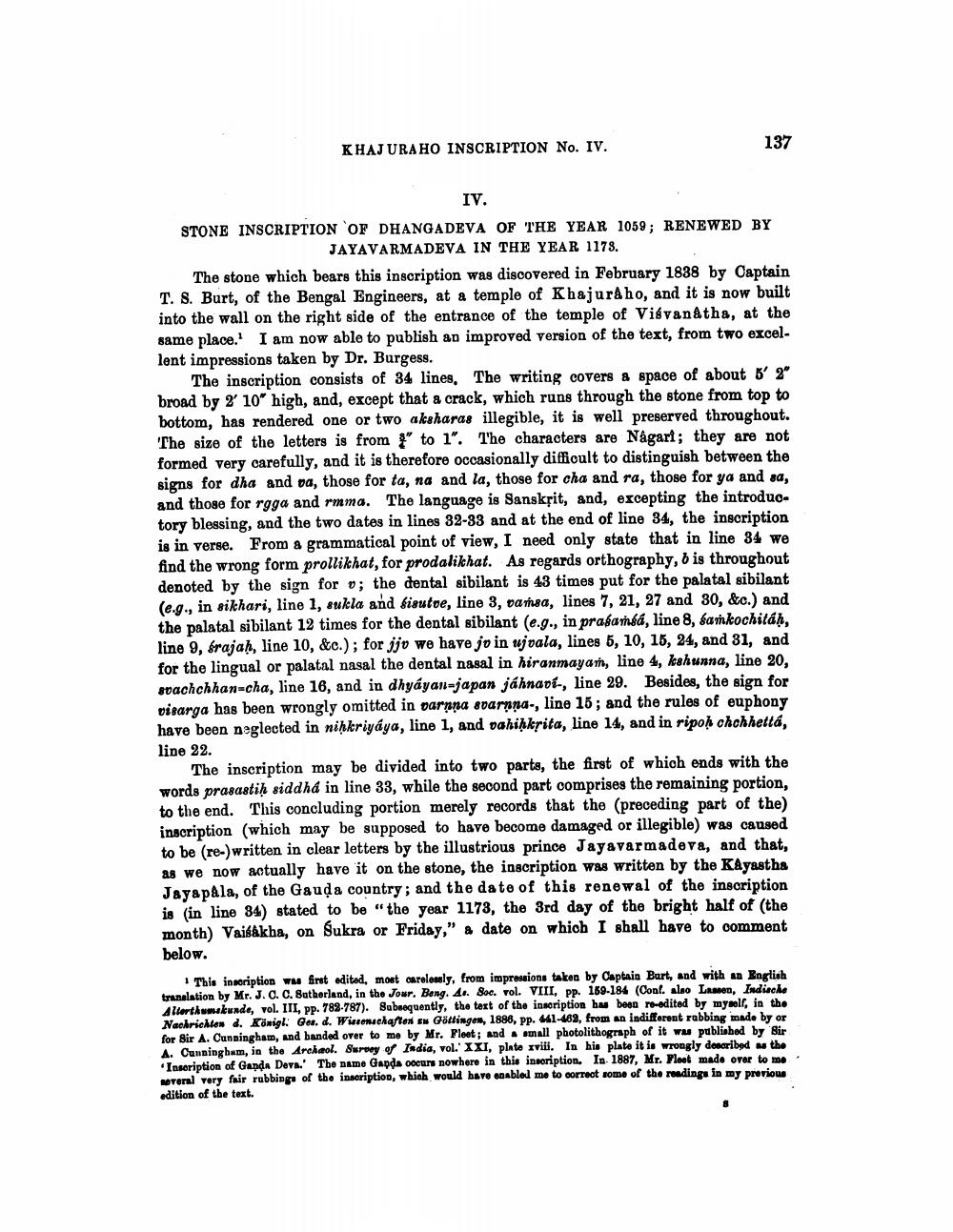________________
KHAJURAHO INSCRIPTION No. IV.
137
broad by
rendered one of
IV. STONE INSCRIPTION OF DHANG ADEVA OF THE YEAR 1059; RENEWED BY
JAYAVARMADEVA IN THE YEAR 1178. The stone which bears this inscription was discovered in February 1838 by Captain T. S. Burt, of the Bengal Engineers, at a temple of Khajuraho, and it is now built into the wall on the right side of the entrance of the temple of Visvanatha, at the same place. I am now able to publish an improved version of the text, from two excellent impressions taken by Dr. Burgess.
The inscription consists of 34 lines. The writing covers & space of about 6' 2 broad by 2' 10" high, and, except that a crack, which runs through the stone from top to bottom, has rendered one or two aksharas illegible, it is well preserved throughout. The size of the letters is from * to 1". The characters are Nagart; they are not formed very carefully, and it is therefore occasionally difficult to distinguish between the signs for dha and va, those for ta, na and la, those for cha and ra, those for ya and sa, and those for rgga and rmma. The language is Sanskrit, and, excepting the introduo. tory blessing, and the two dates in lines 32-33 and at the end of line 34, the inscription is in verse. From a grammatical point of view, I need only state that in line 34 we find the wrong form prollikhat, for prodalikhat. As regards orthography, b is throughout denoted by the sign for o; the dental sibilant is 43 times put for the palatal sibilant (e.g., in sikhari, line 1, sukla and bisutne, line 3, varsa, lines 7, 21, 27 and 30, &c.) and the palatal sibilant 12 times for the dental sibilant (e.g., in prabanéá, line 8, samkochitáh, line 9, srajaḥ, line 10, &c.); for jjo we have jo in ujsala, lines 5, 10, 15, 24, and 31, and for the lingual or palatal nasal the dental nasal in hiranmayan, line 4, kshunna, line 20, spachchhan-cha, line 16, and in dhyayan-japan jáhnadi-, line 29. Besides, the sign for visarga has been wrongly omitted in varnna sdarnna-, line 15; and the rules of euphony have been neglected in nihkriyaya, line 1, and dahiņksita, line 14, and in ripoh chchhettá, line 22.
The inscription may be divided into two parts, the first of which ends with the words prasastih siddha in line 33, while the second part comprises the remaining portion, to the end. This concluding portion merely records that the (preceding part of the) inscription (which may be supposed to have become damaged or illegible) was caused to be (re-written in clear letters by the illustrious prince Jayavarmadera, and that, as we now actually have it on the stone, the inscription was written by the Kayastha JayapAla, of the Gauda country, and the date of this renewal of the inscription is (in line 34) stated to be "the year 1173, the 3rd day of the bright half of the month) Vaisakha, on Sukra or Friday," & date on which I shall have to comment below.
1 This inscription was first edited, most carolonely, from impressions taken by Captain Bart, and with an English translation by Mr. J.O.C. Butherland, in the Jour. Beng. 4.. Soc. vol. VIII, pp. 169-184 (Conf. also Lassen, Indiacle Altertumskunde, vol. III, pp. 789-787). Subsequently, the text of the inscription has been re-edited by myself, in the Nachrichten d. Königl. Ges. d. Wissenschaften su Göllingen, 1886, pp. 441-482, from an indifferent rabbing made by or for Bir A. Cunningham, and handed over to me by Mr. Fleet; and small photolithograph of it was published by Bir A. Cunningham, in the Archeol. Survey of India, vol.' XXI, plato xviii. In his plate it is wrongly described the
Inscription of Ganda Deva.' The name Ganda Oeun nowhere in this inscription. In 1887, Mr. Ploot made over to me norerad very fair rubbingo of the inscription, which would have enabled me to correct some of the reading in my previous edition of the text.




